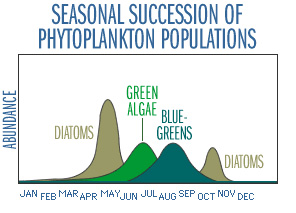Algae types and preferences
Have you ever wondered why at sometimes during the year the
lakes look "greener" than at other times?
The concentration of algae and the types of algae in the lake change
throughout the season. This
pattern is called algal succession.
You can think of it like plants in a garden.
All plants are there for the whole season, but different plants prefer
different conditions and bloom at different times.
Like terrestrial plants, aquatic plants and algae need light and
nutrients to grow and photosynthesize.
 In a lake, there are many different kinds of algae, but we
can group them into 3 main types.
Diatoms are the first to "bloom" in the spring and do best in cold water.
They also give a last hurrah at the end of the season in September.
They can deal with widely variable light levels that occur as the lake is
mixing in the spring. Diatoms are
very small and brownish, so that is why lakes usually look fairly clear in the
spring. If you were to filter lake
water on filter paper in the spring, the residue will look brownish.
In a lake, there are many different kinds of algae, but we
can group them into 3 main types.
Diatoms are the first to "bloom" in the spring and do best in cold water.
They also give a last hurrah at the end of the season in September.
They can deal with widely variable light levels that occur as the lake is
mixing in the spring. Diatoms are
very small and brownish, so that is why lakes usually look fairly clear in the
spring. If you were to filter lake
water on filter paper in the spring, the residue will look brownish.
Once the water warms up and stops mixing, the green algae
out-compete the diatoms. Green
algae are a diverse group and include filamentous algae such as
Spirogyra.
This is the type of algae that form long strings in the water in
mid-summer. Green algae are larger
than diatoms, and are green in color.
That is why the lake looks greener in July and August than in May.
If you were to filter lake water on filter paper in mid-summer, the
residue will look green.
In late summer in lakes and ponds that have a lot of
nutrients (phosphorus), blue-green algae (Cyanobacteria) take over.
This is the type of algae that makes the water look like green paint.
They thrive in warm water, and sunny, calm conditions.
Blue-green algae can be toxic at times, and so far scientists are unable
to predict when the toxins form.
When the water looks like green paint, avoid swimming and letting your dogs swim
or drink from the lake.
You can track the different algae blooms by measuring water
clarity with a secchi disk weekly throughout the summer.
You will see the clarity go up and down throughout the season as the
different types of algae bloom.
Until next week, enjoy the lakes!
Moriya Rufer is the Lakes
Monitoring Program Coordinator for RMB Environmental Laboratories in Detroit Lakes, 218-846-1465,
lakes.rmbel@eot.com.
 In a lake, there are many different kinds of algae, but we
can group them into 3 main types.
Diatoms are the first to "bloom" in the spring and do best in cold water.
They also give a last hurrah at the end of the season in September.
They can deal with widely variable light levels that occur as the lake is
mixing in the spring. Diatoms are
very small and brownish, so that is why lakes usually look fairly clear in the
spring. If you were to filter lake
water on filter paper in the spring, the residue will look brownish.
In a lake, there are many different kinds of algae, but we
can group them into 3 main types.
Diatoms are the first to "bloom" in the spring and do best in cold water.
They also give a last hurrah at the end of the season in September.
They can deal with widely variable light levels that occur as the lake is
mixing in the spring. Diatoms are
very small and brownish, so that is why lakes usually look fairly clear in the
spring. If you were to filter lake
water on filter paper in the spring, the residue will look brownish.